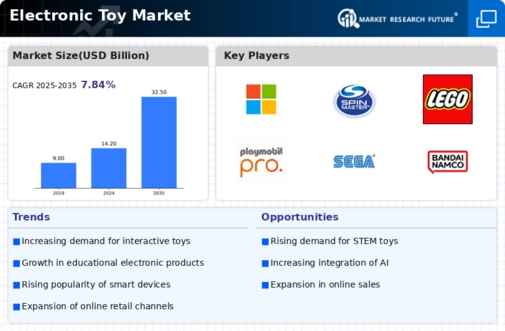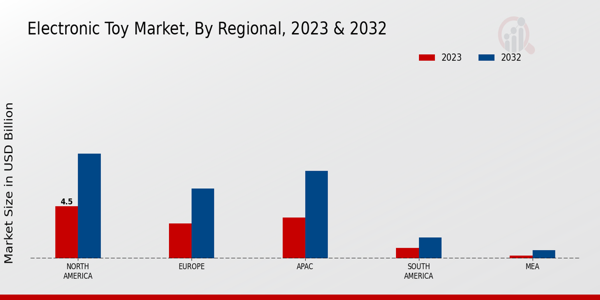Focus on Sustainability
Sustainability is becoming a critical factor in the Global Electronic Toy Market Industry, as consumers increasingly demand eco-friendly products. Manufacturers are responding by developing toys made from recycled materials and implementing sustainable practices in production. This shift not only addresses environmental concerns but also appeals to environmentally conscious consumers. As sustainability becomes a key purchasing criterion, the market is likely to see a rise in demand for eco-friendly electronic toys. This trend may contribute to the overall growth of the industry, as companies that prioritize sustainability could gain a competitive edge.
Market Growth Projections
The Global Electronic Toy Market Industry is poised for substantial growth in the coming years. With a projected market value of 14.2 USD Billion in 2024 and an anticipated increase to 32.5 USD Billion by 2035, the industry is expected to expand significantly. The compound annual growth rate (CAGR) of 7.85% from 2025 to 2035 indicates a robust demand for electronic toys. This growth can be attributed to various factors, including technological advancements, increased disposable income, and a growing focus on educational and sustainable products. The future of the electronic toy market appears promising, with numerous opportunities for innovation and expansion.
Technological Advancements
The Global Electronic Toy Market Industry is experiencing a surge driven by rapid technological advancements. Innovations in artificial intelligence, robotics, and interactive features are enhancing the play experience for children. For instance, toys that incorporate augmented reality are becoming increasingly popular, allowing children to engage in immersive play. This trend is expected to contribute to the market's growth, with projections indicating a market value of 14.2 USD Billion in 2024. As technology continues to evolve, the demand for sophisticated electronic toys is likely to increase, further propelling the industry forward.
Increased Disposable Income
The rise in disposable income across various regions is positively impacting the Global Electronic Toy Market Industry. As families have more financial resources, they are more inclined to invest in high-quality electronic toys that offer enhanced features and educational value. This trend is particularly evident in emerging markets, where economic growth is leading to increased spending on children's products. Consequently, the market is projected to grow at a CAGR of 7.85% from 2025 to 2035, indicating a robust demand for premium electronic toys as consumers seek to provide their children with the best possible play experiences.
Growing Demand for Educational Toys
There is a notable shift towards educational toys within the Global Electronic Toy Market Industry, as parents increasingly prioritize products that promote learning and development. Toys that combine fun with educational content, such as coding robots and STEM kits, are gaining traction. This trend aligns with the growing awareness of the importance of early childhood education, which is reflected in the projected market growth to 32.5 USD Billion by 2035. As parents seek to provide their children with enriching experiences, the demand for educational electronic toys is expected to rise significantly.
Influence of Social Media and Online Marketing
The Global Electronic Toy Market Industry is significantly influenced by social media and online marketing strategies. Platforms such as Instagram and YouTube serve as powerful tools for toy manufacturers to showcase their products and engage with consumers. Influencer marketing, in particular, has proven effective in reaching target audiences, as parents often rely on recommendations from trusted figures. This digital marketing approach is likely to drive sales and brand awareness, contributing to the industry's growth. As online shopping continues to gain popularity, the visibility of electronic toys is expected to increase, further enhancing market dynamics.
















